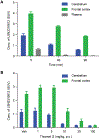PET ligands [18F]LSN3316612 and [11C]LSN3316612 quantify O-linked-β- N-acetyl-glucosamine hydrolase in the brain
- PMID: 32404505
- PMCID: PMC8494060
- DOI: 10.1126/scitranslmed.aau2939
PET ligands [18F]LSN3316612 and [11C]LSN3316612 quantify O-linked-β- N-acetyl-glucosamine hydrolase in the brain
Abstract
We aimed to develop effective radioligands for quantifying brain O-linked-β-N-acetyl-glucosamine (O-GlcNAc) hydrolase (OGA) using positron emission tomography in living subjects as tools for evaluating drug target engagement. Posttranslational modifications of tau, a biomarker of Alzheimer's disease, by O-GlcNAc through the enzyme pair OGA and O-GlcNAc transferase (OGT) are inversely related to the amounts of its insoluble hyperphosphorylated form. Increase in tau O-GlcNAcylation by OGA inhibition is believed to reduce tau aggregation. LSN3316612, a highly selective and potent OGA ligand [half-maximal inhibitory concentration (IC50) = 1.9 nM], emerged as a lead ligand after in silico analysis and in vitro evaluations. [3H]LSN3316612 imaged and quantified OGA in postmortem brains of rat, monkey, and human. The presence of fluorine and carbonyl functionality in LSN3316612 enabled labeling with positron-emitting fluorine-18 or carbon-11. Both [18F]LSN3316612 and [11C]LSN3316612 bound reversibly to OGA in vivo, and such binding was blocked by pharmacological doses of thiamet G, an OGA inhibitor of different chemotype, in monkeys. [18F]LSN3316612 entered healthy human brain avidly (~4 SUV) without radiodefluorination or adverse effect from other radiometabolites, as evidenced by stable brain total volume of distribution (VT) values by 110 min of scanning. Overall, [18F]LSN3316612 is preferred over [11C]LSN3316612 for future human studies, whereas either may be an effective positron emission tomography radioligand for quantifying brain OGA in rodent and monkey.
Copyright © 2020 The Authors, some rights reserved; exclusive licensee American Association for the Advancement of Science. No claim to original U.S. Government Works.
Conflict of interest statement
Figures





References
-
- Holtzman DM, Carrillo MC, Hendrix JA, Bain LJ, Catafau AM, Gault LM, Goedert M, Mandelkow E, Mandelkow EM, Miller DS, Ostrowitzki S, Polydoro M, Smith S, Wittmann M, Hutton M, Tau: From research to clinical development. Alzheimer's Dement. 12, 1033–1039 (2016). - PubMed
-
- Arendt T, Stieler JT, Holzer M, Tau and tauopathies. Brain Res. Bull 126, 238–292 (2016). - PubMed
Publication types
MeSH terms
Substances
Grants and funding
LinkOut - more resources
Full Text Sources
Medical
Miscellaneous

